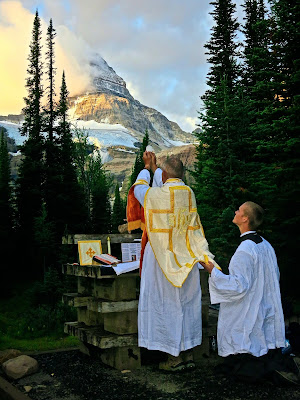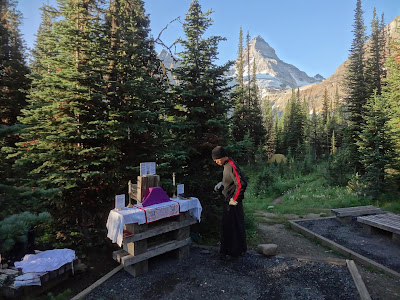Worthily Celebrating the Holy Sacrifice of the Mass Outdoors
 Now that we (at least in the Northern Hemisphere) are on the verge of summer and all the outdoor activities and traveling it makes possible, it seems worthwhile to discuss the phenomenon of outdoor Masses, which, if anything, seems to be growing in popularity as time goes on.To state the obvious, there may not always be a good reason for having an outdoor Mass. As we know, Canon Law specifies that the normative place for worship is a consecrated church or chapel. On the other hand, if you are a group of Catholics who are going on a fairly long-term wilderness trek and you will be many miles (and even mountains) away from civilization, or if you are undertaking a multi-day pilgrimage from one shrine to another, then packing the Mass along with you may be exactly the right thing to do.But it still must be done correctly — that is, reverently, with all essentials for the rite, and with no danger of profanation. In short, if one is going to have Mass outdoors, it must be done well; and if, for whatever reason, this is not possible, it would be better not to do it. Fr. Pierre-Jean De Smet (1801–1873), a true apostle of the American West, once said that one of the hardest things about being a missionary was how many times he couldn’t celebrate Mass because conditions were too hard.I became interested in the question of outdoor Masses initially because of my involvement with Wyoming Catholic College, which features an intensive Outdoor Leadership Program that sends out all the freshmen on a three-week backpacking trip in the wilderness, with chaplains accompanying them for the first two weeks. Other outdoor trips, such as the freshmen’s week-long winter trip, have also been blessed by the presence and ministrations of our resident chaplains. I myself was fortunate to participate in a 12-day backpacking trip a few summers ago that was graced by the companionship of a Fraternity of St. Peter priest who offered the traditional Mass daily in the midst of some of the most breathtaking country I had ever seen. We even sang a High Mass for the Feast of the Transfiguration (I had packed a photocopy of the propers and ordinary).My purpose here is to gather in a single article a sizeable number of photographs and pointers about outdoor Masses. In my opinion, someday a priest of traditional sensibilities who is at the same time highly experienced in backpacking trips and other outdoor events should write a comprehensive and amply illustrated book on the subject. While we await that publication, however, at least we have some wonderful photos to look to for inspiration and guidance, as well as ten pieces of advice that Fr. Antony Sumich, FSSP, shared with me as I was drafting this article.
Now that we (at least in the Northern Hemisphere) are on the verge of summer and all the outdoor activities and traveling it makes possible, it seems worthwhile to discuss the phenomenon of outdoor Masses, which, if anything, seems to be growing in popularity as time goes on.To state the obvious, there may not always be a good reason for having an outdoor Mass. As we know, Canon Law specifies that the normative place for worship is a consecrated church or chapel. On the other hand, if you are a group of Catholics who are going on a fairly long-term wilderness trek and you will be many miles (and even mountains) away from civilization, or if you are undertaking a multi-day pilgrimage from one shrine to another, then packing the Mass along with you may be exactly the right thing to do.But it still must be done correctly — that is, reverently, with all essentials for the rite, and with no danger of profanation. In short, if one is going to have Mass outdoors, it must be done well; and if, for whatever reason, this is not possible, it would be better not to do it. Fr. Pierre-Jean De Smet (1801–1873), a true apostle of the American West, once said that one of the hardest things about being a missionary was how many times he couldn’t celebrate Mass because conditions were too hard.I became interested in the question of outdoor Masses initially because of my involvement with Wyoming Catholic College, which features an intensive Outdoor Leadership Program that sends out all the freshmen on a three-week backpacking trip in the wilderness, with chaplains accompanying them for the first two weeks. Other outdoor trips, such as the freshmen’s week-long winter trip, have also been blessed by the presence and ministrations of our resident chaplains. I myself was fortunate to participate in a 12-day backpacking trip a few summers ago that was graced by the companionship of a Fraternity of St. Peter priest who offered the traditional Mass daily in the midst of some of the most breathtaking country I had ever seen. We even sang a High Mass for the Feast of the Transfiguration (I had packed a photocopy of the propers and ordinary).My purpose here is to gather in a single article a sizeable number of photographs and pointers about outdoor Masses. In my opinion, someday a priest of traditional sensibilities who is at the same time highly experienced in backpacking trips and other outdoor events should write a comprehensive and amply illustrated book on the subject. While we await that publication, however, at least we have some wonderful photos to look to for inspiration and guidance, as well as ten pieces of advice that Fr. Antony Sumich, FSSP, shared with me as I was drafting this article.
Two Distinct Scenarios
When celebrating Mass outdoors, there are two distinct scenarios:
- the “no holds barred” scenario, where, either due to the use of vehicles or a large number of people who can carry objects and don’t have to stay outdoors for a long period, one can set up the Mass with a certain fullness, including the use of tents, a portable altar, tall candlesticks, statues, chairs, and so forth, resulting in what might be called a temporary chapel;
- the “pack as lightly as you can” scenario, where fewness and lightness of objects is key, because the priest and his companions will be backpacking a long distance and carrying on their backs all their own food and gear.
Of course, these two scenarios are not separated by a sharp line, and, in practice, one sees a variety of approaches and levels. The usus antiquior requires more items than the Novus Ordo, but, as the photos demonstrate, portable versions of everything have been developed with great ingenuity. (I suggest checking out St. Joseph's Apprentice, a company that offers many models, including the "Wilderness Altar." OnePeterFive ran a fascinating article by the carpenter who founded it.)
(1) Scenario 1: A Temporary Outdoor Chapel
Over the years, NLM has featured photos from many outdoor Masses that fit the description of the first scenario. Most notable, of course, are the Masses from the annual Chartres pilgrimage.
Another great example is the Mass celebrated by Fr. Sumich on the top of Mt. Kilimanjaro, the highest peak on the African continent. Again, Father was assisted by lay Catholics who served as porters to carry up the table and other items seen in the photos.


 An additional photo that would belong to this category:
An additional photo that would belong to this category: Other good examples may be found here and here.
Other good examples may be found here and here.
(2) Scenario 2: Backpacking in the Wilderness
NLM has not featured many photos in the all-out wilderness category. An exception would be the photos from a Wyoming Catholic College winter trip on which freshmen vied with one another to create the best snow altars and sanctuaries in January in the environs of the Grand Tetons.Here are some photos from the WCC faculty-staff backpacking trip for which Fr. Terence Gordon, FSSP, served as chaplain:
(3) Hybrid
A hybrid of the two scenarios would be the case where one is staying at a camp ground and has at one’s disposal various materials, such as a picnic table or large logs or boards, that would not be available in the wilderness.

 At a Game Park in Zimbabwe
At a Game Park in Zimbabwe At Yoho Park, British Columbia
At Yoho Park, British Columbia Mass at 5 degrees Fahrenheit
Mass at 5 degrees Fahrenheit


Ten Pieces of Advice
Fr. Sumich shared with me the following advice, for the benefit of priestly readers of NLM.Saying Mass in these outdoor spots requires very good organisation and precise planning.
- Early mornings usually have the best chance for ‘no wind’ which is very important. Although I was saying Mass in the Namib Desert just before sunrise and a howling wind came up and I had to stop the Mass at about the Epistle!
- The linens will need either clips or stones to stop from blowing.
- The candles are difficult to keep lit. The storm candles worked quite well on Kilimanjaro, but still needed work.
- If carrying two sets of reversible vestments, they need to be able to fold up into one ziplock bag each (the whole set!)
- The altar that I used on Kilimanjaro was fantastic as it gave me another 8 - 10” height above a standard fold-out table. This helps to stop stooping to say Mass. But this only can be used if you have porters. In the bush, it would be too much to carry & you need to construct your own altar.
- You need a crush resistant (but very compact) & waterproof container for hosts.
- The missal needs (obviously) to be small, but too small can sometimes be too hard to read.
- Things will get dirty, but folding vestments and especially altar linens and albs very closely & tightly to a set pattern CAN keep them from soiling too bad. Zip-locks are fantastic.
- Depending on the numbers, either a very small ciborium or a pyx is best for numbers of hosts.
- It is possible to say Mass in the cold, but when the water cruet can’t stop freezing, you are in trouble. Keeping the celebrant’s hands warm is also difficult because the fingers are exposed and the chalice will be very cold. I have seen a photo of a Mass at the North Pole at an ice altar!
The experiences of many people, as documented in the photos above, demonstrate that it is indeed possible to celebrate the sacred mysteries in the back country with great care, reverence, and attention to detail. I would like to thank all the priests who have done this well and who are therefore in a position to show others how to do it well.
